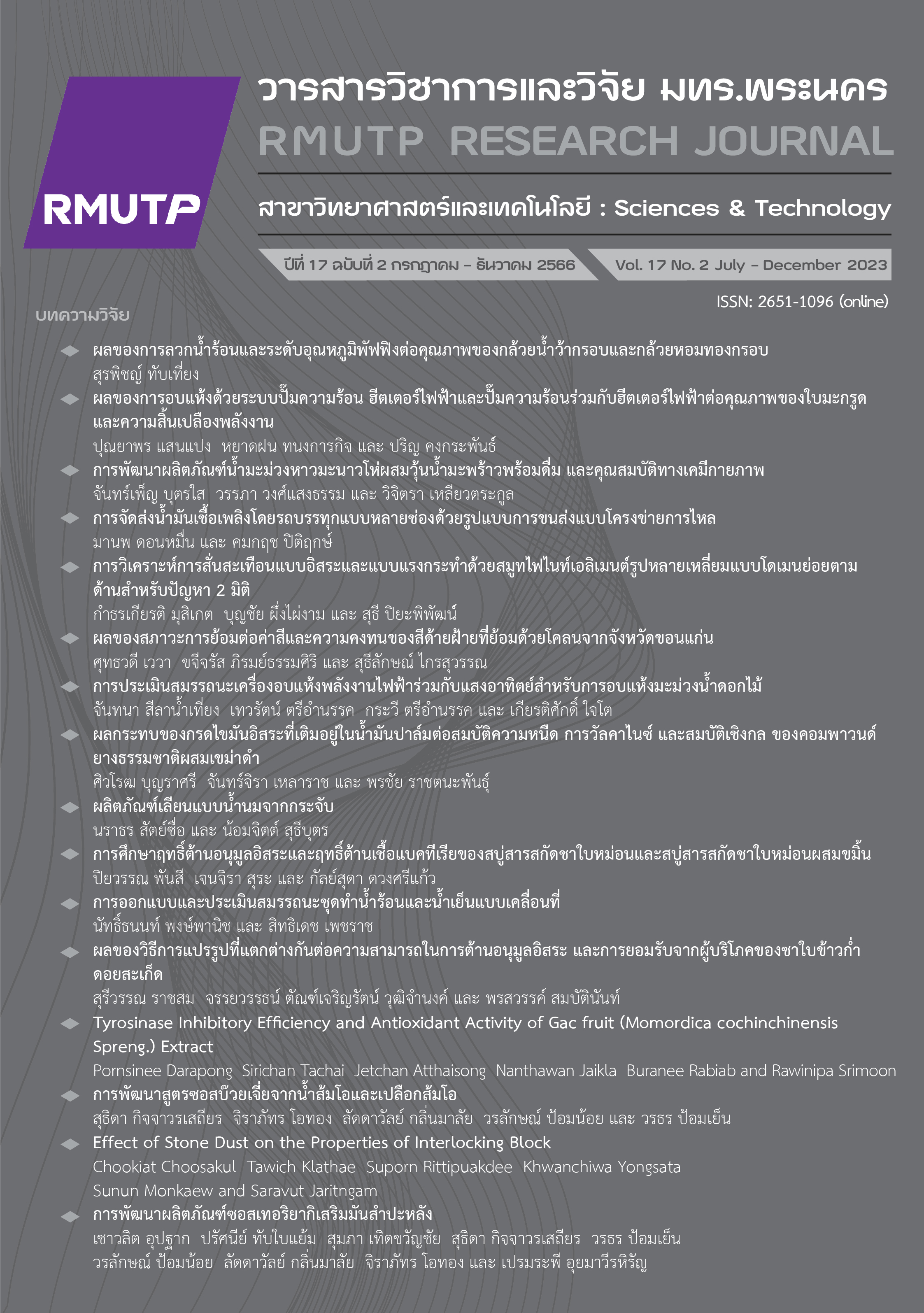Performance Evaluation of Electrical-Solar Combined Energy Dryer for Nam Dok Mai Mango Drying
Main Article Content
Abstract
The objective of this research was to evaluate performance of a solar-electrical combined energy dryer by drying Nam Dok Mai mango. The dryer consists of 3 sets of 2x1 m2 solar collector, 2 sets of 1500 watts of the finned heater, and a drying chamber size of 0.6x0.6x0.6 m3. Nam Dok Mai mango weight of 4 kg with initial moisture content of 84.44% (wet basis) was dried with drying air temperature of 60, 70, and 80°C and drying air flow rate of 0.034 kg/s until the final moisture content was less than 18% (wet basis). The performance of drying was evaluated by efficiency of solar collector, Specific electrical energy consumption (SEEC) and drying rate. The quality was evaluated by moisture content, color difference, and texture profile consists of hardness, cohesiveness, springiness, and chewiness. The result shown that, drying with temperature of 60°C has the best qualities of dried product with the lowest color difference, optimum texture, with moisture and water activity are up to the industry standard of dried fruit. The solar collector set has highest efficiency of 46.36%, the lowest of the specific electrical energy consumption of 12.57 MJ/kg, which can be save electrical energy of 27.15%
Article Details

This work is licensed under a Creative Commons Attribution-NonCommercial-NoDerivatives 4.0 International License.
ลิขสิทธ์ ของมหาวิทยาลัยเทคโนโลยีราชมงคลพระนครReferences
A. Fudholi, K. Sopian, M.H. Ruslan, M.A. Alghoul and M.Y. Sulaiman, “Review of solar dryers for agricultural and marine products,” Renewable and Sustainable Energy Reviews, vol.14, pp. 1-30, 2010.
R.H.B. Exell, “The Fluctuation of Solar Radiation of Thailand,” Solar Energy, Vol. 18, pp 549 – 554, 1976.
I. Dincer, “Moisture loss from wood products during drying-Part I: moisture diffusivities and moisture transfer coefficients,” Energy Sources, vol.20, pp 67-75, 1998.
A.G.M.B. Mustayen, S. Mekhilef and R. Saidur, “Performance study of different solar dryers: A review,” Renewable and Sustainable Energy Reviews, vol.34, pp 463–470, 2014.
M.S. Sodha, N.K. Bansal, K. Kumar, P.K. Bansal and M.A.S. Malik, “Solar crop drying, vol.1,” Florida, USA, C. R. C. Press, Palm Beach, 1987.
O.V. Ekechukwu and B. Norton, “Review of solar-energy drying systems II: an overview of solar drying technology,” Energy Conversion & Management, vol.40, pp 615–655, 1999.
A.A. El-Sebaii and S.M. Shalaby, “Solar drying of agricultural products: a review,” Renewable and Sustainable Energy Reviews, vol.16, pp 37–43, 2012.
A. B. Lingayat, V.P. Chandramohan, V.R.K Raju and V. Meda, “A review on indirect type solar dryers for agricultural crops – Dryer setup, its performance, energy storage and important highlights,” Applied Energy, vol. 258, 2022.
C. Tiris, M. Tiris and I. Dincer, “Experiments on the a new solar air heater,” International Communications in Heat and Mass Transfer, vol.16, pp 183–7, 1996.
T. Yaibok, S. Phethuayluk, J. WeawSak, M. Mani and P. Buaphet, "Development the Fish Drying Process with a Solar-Electrical Combined Energy Dryer under the Southern of Thailand Climate," Thaksin University Journal, vol. 12, no. 3, pp. 109–118, 2010.
S. Sombatpraiwan, T. Tipyavimol, K. Treeamnuk, “Factors Related to Ripening-stages of Nam Dok-mai Mango after Harvesting,” Journal of the Thai Society of Agricultural Engineering vol. 18, no. 1, pp. 52–58, 2012.
Horwitz, W., “Official Methods of AOAC International” 17th ed, Association of Official Analytical Chemists (AOAC) International, Gaithersburg, 2000.
J. Seelanamtiang, T. Treeamnuk, and K. Treeamnuk, "Effect of Blanching Pretreatment on Physical Properties and Texture of Dried Chok-Anun Mango," In Proceeding of the 22th TSAE National Conference and the 14th TSAE International Conference, Faculty of Engineering Khon Kaen University, Thailand, 2021, pp. 161-165.
Office of Industrial Product Standards, Ministry of Industry, Bangkok, “Dried Fruit Industrial Standard,” TIS. 919- 2563.
N. Saelim, T. Treeamnuk and K. Treeamnuk, “Development of a Continuous Flow Paddy Dryer with Infrared Radial Radiation Technique,” RMUTP Research Journal, vol. 12, no. 2, pp. 37-46, 2018.
K. Jaito, T. Treeamnuk, K. Treeamnuk and N. Prangpru, “Shredded-Coconut Drying by Spouted-Bed Technique for Cold Press Coconut Oil Production,” Thai Society of Agricultural Engineering Journal, vol. 22, no. 1, pp 64-72, 2016.
E.O.M. Akoy, “Experimental characterization and modeling of thin-layer drying of mango slices,” International Food Research Journal, vol.21, pp 1911-1917, 2014.
W. Sriariyakul, “Drying of Nam Dok Mai Mango Using Far-Infrared Radiation in Combination with Hot-Air” The Journal of Industrial Technology, vol17, no. 3, pp 16-182, 2021.
P.N. Sarsavadia, “Development of solar-assisted dryer and evaluation of energy requirement for the drying of onion,” Renewable Energy, vol.32, pp 2529–47, 2007.
R. Kumwan, S. Thiangchanta and S. Kesai, “Determination of Drying Rate of Jackfruit by Infrared Dryer, Vacuum System,” Industrial Technology Lampang Rajabhat University Journal, vol.11, no. 2, pp. 67-77, 2018.
G.M. Sapers and Jr.F.W. Douglas, “Measurement of enzymatic browning at cut surfaces and in juice of raw apple and pear fruits,” Journal Food Science, vol.52, pp. 1258-1261, 1987,
S. Inthachai, N. Meeso, S. Siriamornpun, “Use of hot-air from solar energy combined with gas fuel in coated wood furniture drying” Journal of Science and Technology Mahasarakham University, vol. 32, no. 5, pp. 659-663, 2013.


